The post Building Healthcare Apps: Integrating EHR Functionality For Better Patient Management appeared first on nandbox Native App Builder.
]]>Let’s dive into what it takes to build healthcare apps with EHR integration, focusing on how this technology can transform patient management, with a special look at mental health care.
The Importance Of EHR Integration In Healthcare Apps
Electronic health records have revolutionized how patient information is stored, accessed, and managed. For years, clinics and hospitals struggled with paper records that were inefficient, prone to errors, and hard to share between healthcare providers.
EHRs solved these issues by digitizing patient records and making them accessible in real-time. But, as healthcare moves into the mobile and digital world, there’s now a strong demand for apps that provide easy access to these EHR systems.
Integrating EHR functionality into healthcare apps is a game-changer because it:
- Improves patient management by giving healthcare providers access to up-to-date medical histories, lab results, and treatment plans
- Enhances patient engagement through features like appointment scheduling, medication reminders, and telehealth consultations
- Reduces administrative burdens with automatic updates, billing, and insurance information integration
- Supports care coordination by allowing different providers to access the same patient data, fostering collaboration
But achieving seamless Oncology EMR integration in healthcare apps is no small feat. There are significant challenges and considerations, from privacy concerns to interoperability, but the rewards far outweigh the efforts.
Challenges Of Integrating EHRs In Healthcare Apps
Building an app that can handle sensitive patient data while staying compliant with healthcare regulations is tricky. Here are some of the biggest challenges developers face when integrating EHRs into healthcare apps:
Interoperability
Interoperability is perhaps the most critical hurdle to overcome. EHR systems must be able to “talk” to one another, ensuring that patient data can be shared across different platforms and systems. Unfortunately, not all EHR systems are built with easy integration in mind.
To ensure your app communicates effectively with various EHR systems, developers need to adhere to universal standards like Health Level Seven (HL7) or Fast Healthcare Interoperability Resources (FHIR).
Data Security And HIPAA Compliance
When you’re dealing with healthcare apps, security is paramount. Patient health information (PHI) is highly sensitive, and developers must ensure that their apps comply with data protection regulations like the Health Insurance Portability and Accountability Act (HIPAA) in the U.S. This means implementing encryption, secure user authentication, and audit trails to track who is accessing patient information.
User-Friendly Design
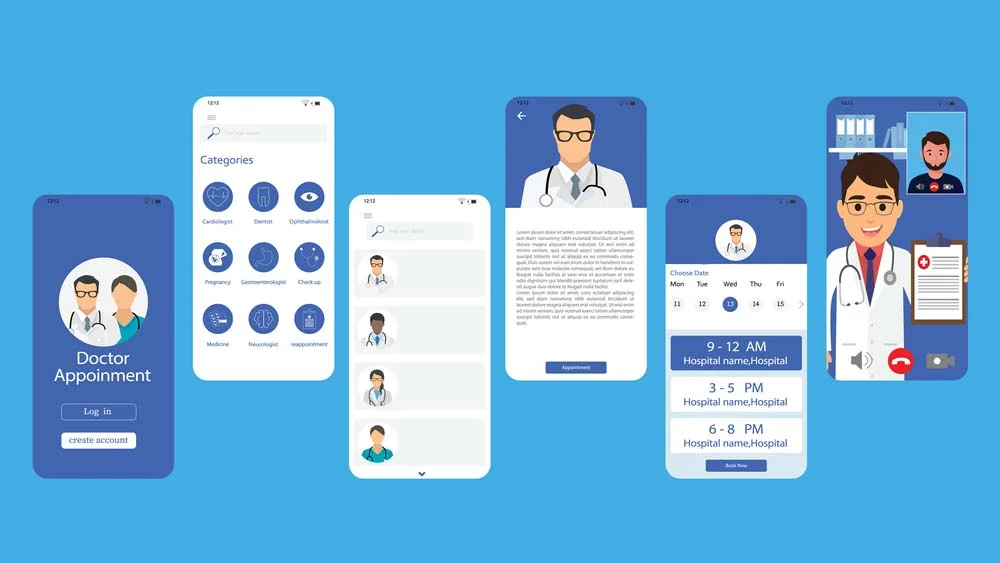
While all-encompassing EHR functionality is critical, the app also needs to be user-friendly. Doctors, nurses, and patients are already dealing with enough complexity. The app should offer a seamless, intuitive experience where users can easily navigate through the information they need. A clunky interface can undermine the benefits of having access to EHR data at your fingertips.
Customization And Flexibility
Healthcare providers often have unique workflows and data requirements. An EHR system that works for a psychiatric clinic may not be suitable for a general hospital. It’s important to build healthcare apps that can be customized for various specialties and practices.
For instance, apps designed for mental health professionals might focus on therapy notes, behavioral assessments, and mood tracking features. When looking for the best EHR for psychiatry, it’s essential to find one that integrates smoothly with the specific needs of mental health practitioners.
Benefits Of Integrating EHRs Into Healthcare Apps
Now that we’ve explored the challenges, let’s turn to the benefits. When done right, integrating EHRs into healthcare apps offers a wide array of advantages, not just for healthcare providers but for patients as well.
Improved Patient Outcomes
With EHR functionality, healthcare apps allow providers to quickly access a patient’s medical history, current medications, allergies, and treatment plans. This leads to more informed decision-making, reducing the chances of medical errors and improving overall patient outcomes.
For example, if a patient is admitted to an emergency room, doctors can instantly access their EHR, knowing about previous diagnoses or surgeries that could affect treatment.
Better Patient Engagement
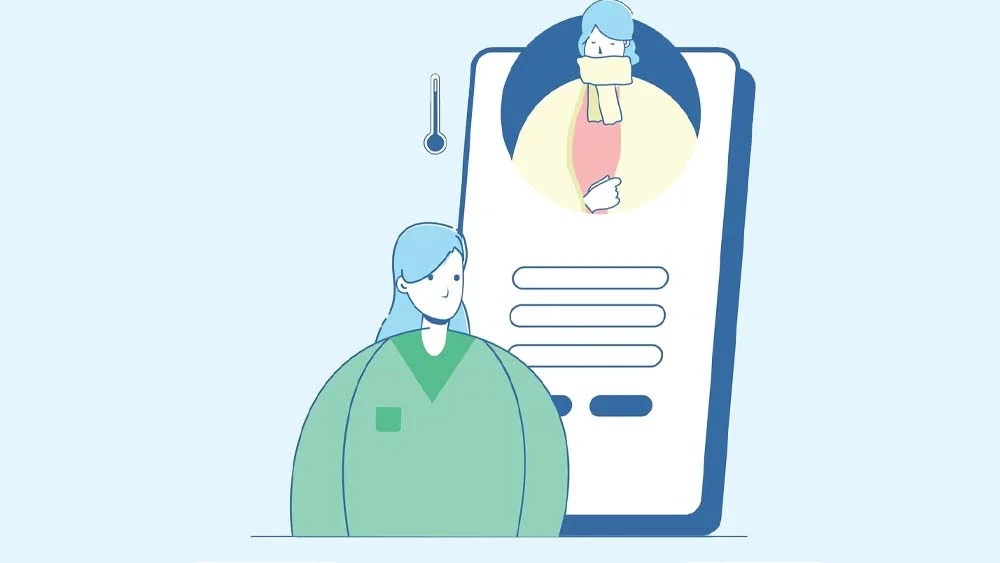
Patients are becoming increasingly involved in their own care. EHR-integrated apps allow patients to book appointments, access lab results, communicate with their doctors, and even refill prescriptions—all from their smartphone. This high level of accessibility keeps patients engaged and more likely to follow through with their treatment plans.
Additionally, these apps often feature educational resources, helping patients better understand their health conditions and care options.
Efficient Workflows For Healthcare Providers
By integrating EHRs into healthcare apps, many repetitive administrative tasks are automated. For instance, billing and insurance information can be updated automatically, and patient data doesn’t need to be manually entered across different platforms. This saves healthcare providers time and reduces the risk of errors. It also frees up more time for patient care rather than paperwork.
Tailored Solutions For Specialties
One of the most exciting aspects of integrating EHRs into healthcare apps is the potential for specialized solutions. Developers can build apps tailored to specific medical fields, such as mental health, oncology, or pediatrics.
Take mental health, for example. When integrating features like therapy notes, mood tracking, or appointment scheduling, having the best mental health EMR integrated into the app can vastly improve the workflow for therapists and psychologists.
Key Features To Include In Healthcare Apps With EHR Integration
When building a healthcare app that integrates EHR functionality, certain features are essential to ensure it provides value to both providers and patients. Here are some must-have features:
- Appointment Scheduling and Reminders: Allows patients to book, cancel, or reschedule appointments with ease while receiving automated reminders
- Prescription Management: Enables healthcare providers to prescribe medications electronically and track patient adherence
- Telemedicine Capabilities: With telehealth becoming more prominent, the app should include options for virtual consultations, especially for specialties like psychiatry or behavioral health
- Access to Lab Results and Medical History: Patients and providers can review test results, diagnoses, and treatment plans directly from the app
- Patient Communication Tools: Secure messaging systems allow patients to ask questions, report symptoms, or request prescription refills
- Customizable Dashboards for Providers: Healthcare providers can benefit from dashboards that display patient information, analytics, and alerts, customized for their specific needs
Conclusion: The Future Of Healthcare Apps With EHR Integration
As technology continues to evolve, healthcare apps with EHR integration will become even more sophisticated. Artificial Intelligence (AI) and machine learning could be used to analyze EHR data, offering predictive insights to healthcare providers, while wearables and IoT devices could feed real-time health data directly into a patient’s EHR. This integration will continue to revolutionize patient management, offering unprecedented levels of care, efficiency, and personalization.
Incorporating EHR functionality into healthcare apps is essential for improving patient care, increasing efficiency, and enhancing patient engagement. While there are challenges, including interoperability and data security, the benefits far outweigh the complexities.
From improving patient outcomes to creating more efficient workflows, EHR integration is at the heart of the digital transformation in healthcare. As the demand for tailored solutions, especially in areas like mental health, continues to grow, developers and healthcare providers alike must stay ahead of the curve by embracing this transformative technology.
By focusing on patient-centered care and seamless data access, healthcare apps with integrated EHR systems will continue to shape the future of the healthcare industry.
The post Building Healthcare Apps: Integrating EHR Functionality For Better Patient Management appeared first on nandbox Native App Builder.
]]>The post How Technology Is Streamlining Veterinary Practice Management appeared first on nandbox Native App Builder.
]]>From AI-driven diagnostic tools to sophisticated practice management software, technology is not only improving the quality of care provided to animals but also optimizing communication between veterinarians and pet owners. The U.S. veterinary reference laboratories market was valued at $660 million for production animals and $315 million for companion animals in 2016. As we explore further, it becomes clear that advancements in technology are raising the bar for veterinary care.
The Digital Revolution in Veterinary Care
The integration of technology in veterinary practices is no longer just a trend; it’s become essential. With advancements in artificial intelligence (AI) and digital tools significantly enhancing diagnostic accuracy, the effects on practice management efficiency and animal care outcomes are profound.
This digital revolution is redefining the standards for how veterinary clinics operate and provide care for our beloved pets, ensuring more precise treatments and efficient service delivery. Also, modern veterinary practices are adopting digital tools to enhance communication with pet owners, improving engagement and compliance.
Streamlining Administrative Tasks
One of the key advantages of incorporating technology into veterinary practices is the automation of labor-intensive administrative tasks.
Automating processes such as billing, invoicing, and record-keeping significantly reduces the hours spent on these tasks. The time saved each week allows for:
- Enhanced Patient Care: Veterinary staff can dedicate more attention to patient care, ensuring animals receive the best possible treatment.
- Reduced Staff Stress: Less time spent on paperwork reduces stress, allowing staff to focus on more rewarding aspects of their jobs.
- Improved Work-Life Balance: Practice owners and employees benefit from better work-life balance, contributing to overall job satisfaction and productivity.
Moreover, these technological improvements can significantly impact veterinary practice valuation multiples, potentially increasing the overall value of the practice due to enhanced efficiency and profitability.
This boost in valuation not only reflects improved day-to-day operations but also makes the practice more appealing to potential buyers or investors, who value advanced, scalable solutions.
Core Technological Innovations Transforming Veterinary Practices
Artificial Intelligence and Machine Learning in Veterinary Medicine
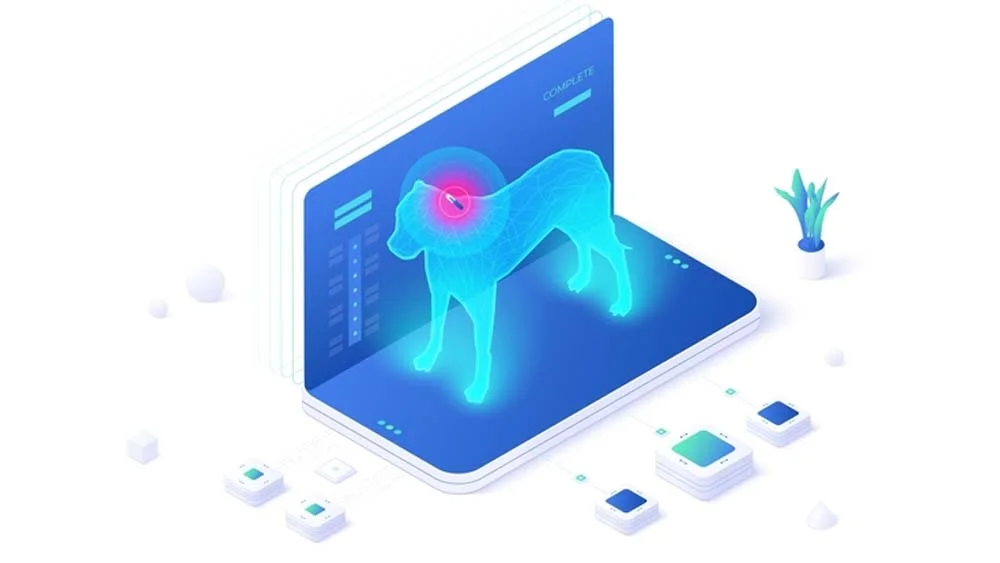
- Current Usage and Familiarity
- AI has become an integral part of veterinary medicine, widely used for diagnostic imaging, and increasingly familiar to most practitioners.
- Key Benefits of AI
- Enhanced Diagnostics: AI significantly improves accuracy through sophisticated image analysis.
- Speed: Accelerates the interpretation of complex medical data.
- Personalized Care: Allows for the creation of tailored treatment plans using extensive data analysis.
Practice Management Information Systems (PIMS)
- Role in Veterinary Practices
- PIMS is critical for enhancing the smooth operation of veterinary clinics by integrating various administrative tasks.
- Core Functions
- Record Management: Helps in the efficient management of electronic medical records.
- Scheduling: Facilitates appointment bookings and sends reminders.
- Inventory: Manages inventory levels and automates ordering.
- Financials: Aids in billing and financial reporting.
- Impact
- PIMS frees up veterinary staff to focus more on direct animal care by automating essential administrative functions.
Digital Communication Tools
- Adoption and Impact
- Modern veterinary practices are adopting digital tools to enhance communication with pet owners, improving engagement and compliance.
- Benefits
- Compliance: Boosts rates of appointment and medication adherence.
- Client Satisfaction: Elevates overall satisfaction through effective and timely communication.
- Strategic Importance
- These tools play a vital role in keeping pet owners informed and engaged, ensuring continuous care that extends beyond the clinic walls.
Enhancing Diagnostic and Treatment Capabilities

This is where technology and veterinary medicine have integrated to improve the accuracy of diagnosis and hasten the treatment process. Digitization of radiography and laboratory equipment has greatly reduced the time used in diagnosis.
This huge reduction in the time taken for diagnosis has allowed veterinarians to make quicker and more informed treatment decisions, which is of vital importance in emergency or critical care situations, thereby saving lives.
Improving Client and Patient Care
Wearable technology for pets brought in new levels of proactive health monitoring, whereby a veterinarian could much more effectively diagnose health issues earlier, monitor chronic conditions better, and recommend personalized care with pinpoint accuracy.
Additionally, through mobile applications and web portals, health records, appointment schedules, and even educational resources are easily accessible to owners. Integration of technology further reinforces the partnership between the veterinarian and client in managing pet health for better outcomes and informed decision-making.
Comparing Traditional vs. Technology-Enhanced Veterinary Practices
To illustrate the transformative impact of technology on veterinary practice management, let’s compare traditional methods with technology-enhanced approaches:
| Aspect | Traditional Practice | Technology-Enhanced Practice |
| Record Keeping | Paper-based charts | Electronic medical records |
| Appointment Scheduling | Phone calls and manual entry | Online booking and automated reminders |
| Diagnostic Imaging | Film-based X-rays | Digital radiography with AI-assisted analysis |
| Client Communication | Primarily phone and in-person | Multi-channel: email, SMS, app notifications |
| Inventory Management | Manual counting and ordering | Automated tracking and reordering systems |
| Billing | Manual invoicing and payment processing | Integrated POS systems with digital payment options |
| Health Monitoring | Periodic check-ups | Continuous monitoring through wearable devices |
| Treatment Planning | Based on individual vets’ experience | AI-assisted, data-driven recommendations |
Navigating the Challenges of Adoption and Integration
Integrating advanced technology into veterinary practices offers substantial benefits but comes with its own set of challenges:
- Initial Implementation Costs: Substantial upfront investments can be a hurdle, particularly for smaller practices or those with tight budgets.
- Training Needs: A significant number of practices encounter difficulties in training staff to use new systems effectively.
- Data Security Concerns: With more patient records and financial information being digitized, robust cybersecurity measures are crucial to protect sensitive data.
- Resistance to Change: Overcoming hesitancy among staff members who prefer traditional methods requires clear communication of benefits and comprehensive training.
- Maintaining the Human Touch: As practices lean more on technology, ensuring the preservation of personal connections in veterinary care is essential.
The Future of Veterinary Practice Management
Looking ahead, the integration of technology within veterinary practices is poised to deepen, driven by several emerging trends and technologies:
- Telemedicine: This enables remote consultations and follow-ups for non-emergency cases, greatly improving access to veterinary care for pet owners regardless of location.
- 3D Printing: Veterinarians can use this technology to create custom prosthetics and surgical models, which can enhance the precision and effectiveness of complex procedures.
- Virtual Reality (VR): VR serves as an advanced educational tool, offering immersive training experiences for veterinary students and professionals seeking continuing education.
- Blockchain: This technology offers enhanced traceability for pet medications and supplies, ensuring authenticity and proper tracking throughout the supply chain.
- Advanced Diagnostics: Innovations like next-generation sequencing are pushing the boundaries of disease identification and treatment planning, offering more precise and tailored veterinary care.
Conclusion
So far, technology adoption within the veterinary practice management process is not a fad; rather, it is an important shift in the way we manage animal healthcare. From AI-assisted diagnostics to comprehensive practice management software, the tools give much power to the professionals for value care with efficiency.
FAQs
How is changing technology helping veterinary medicine and practice?
Advanced technology improves diagnostic precision, enhances treatment options, and optimizes practice management through integrated software solutions.
What is the growing role of technology in a veterinary practice?
Increasingly, technology supports veterinary practices by automating administrative tasks, improving patient diagnostics, and enhancing communication with pet owners.
What are the technological advancements for veterinarians?
Key advancements include AI for diagnostic imaging, cloud-based management systems, and mobile health monitoring devices for pets.
The post How Technology Is Streamlining Veterinary Practice Management appeared first on nandbox Native App Builder.
]]>The post How to Integrate Time and Attendance Software with Payroll Systems in Healthcare appeared first on nandbox Native App Builder.
]]>A smooth integration not only saves time and money but also helps maintain accurate employee records, making the payroll process more efficient. Understanding how to integrate these systems effectively can greatly improve overall productivity and reduce administrative burdens in healthcare settings.
Why Integrate Time and Attendance Software with Payroll Systems?
Integrating time and attendance software with payroll systems provides healthcare organizations with numerous benefits. Manually tracking employee hours and processing payroll can be time-consuming and prone to errors. Integration automates this process, ensuring accurate data transfer and reducing the risk of costly mistakes. Here are some benefits of integration:
- Automates data transfer.
- Reduces manual errors.
- Improves payroll accuracy.
- Enhances compliance with labor laws.
- Streamlines operations.
Integrated time and attendance software automates data transfer, reduces manual errors, improves payroll accuracy, enhances compliance with labor laws, and streamlines operations.
What are the Key Steps to Integrate Time and Attendance Software with Payroll Systems?
Integrating these systems involves several important steps. The process requires careful planning and a clear understanding of the organization’s needs to ensure a smooth transition. Here are the key steps to successfully integrating time and attendance management software.
1. Assess Your Current Systems and Needs
Before starting the integration, it’s important to assess your existing time and attendance and payroll systems. Identify issues such as data inaccuracies, manual entry errors, and compliance gaps that need to be addressed. Here are some key areas to focus on during your assessment:
- System compatibility.
- Current workflow challenges.
- Key functionalities needed.
- Compliance requirements.
- Integration goals.
Evaluating your current setup helps identify the gaps and challenges that integration needs to solve. This step ensures that the new system will improve accuracy, reduce manual tasks, and align with the operational demands of your healthcare facility.
2. Choose the Right Software
Choosing the right time and attendance software that seamlessly integrates well with existing payroll management system. Utilizing specialized healthcare time and attendance software solutions can further simplify the process and provide valuable insights into workforce management. Focus on solutions designed to handle healthcare-specific needs, such as tracking varied shift patterns, managing multiple employee roles, and complying with healthcare regulations. Here are the features you should consider when selecting the software:
- Seamless integration capabilities.
- Support for complex shift patterns.
- Compliance with healthcare regulations.
- User-friendly interface.
- Customization options.
Selecting the right software ensures smoother operations, improves employee satisfaction, and minimizes compliance risks.
3. Ensure Compatibility and Integration Capabilities
Not every time attendance software integrates well with existing payroll management system. Ensuring compatibility is vital, as seamless data communication between systems is a cornerstone of successful integration. Look for software that offers APIs or pre-built integrations to facilitate smooth data exchange, real-time updates, and secure data handling. Here’s a checklist to guide you through compatibility considerations:
- API availability.
- Pre-built integrations.
- Data synchronization capabilities.
- Real-time updates.
- Security features.
Ensuring compatibility between systems helps prevent data transfer issues, improves payroll accuracy, and enhances overall system performance.
4. Test the Integration Thoroughly

Thorough testing is essential for a successful integration. Conduct a pilot test with a small group of employees to validate that time and attendance data accurately flows into the payroll system. Here are key areas to focus on during testing:
- Accuracy of time data transfer.
- Correctness of payroll calculations.
- System performance under load.
- Error handling and notifications.
- User Feedback.
Testing ensures the integrated system functions as expected, allowing you to address any errors before full-scale deployment. A well-tested integration boosts confidence in the new system and ensures smooth operations without disrupting payroll processes.
How Can You Overcome the Challenges When Integrating?
Integrating time and attendance software with payroll systems in healthcare can offer numerous benefits, but the process often comes with challenges. Common hurdles include system compatibility issues and employee resistance. Addressing these obstacles proactively is important for a successful and seamless integration.
- Data compatibility issues.
- System compatibility.
- Employee resistance.
- New software integration.
- Software vendors.
- Inaccuracies.
Managing these challenges requires working closely with software vendors to resolve compatibility issues and providing adequate training to reduce employee resistance. Understanding these potential hurdles helps ensure a smoother transition to an integrated system that enhances overall efficiency.
What Best Practices Should Be Adopted for Successful Integration?
Successfully integrating time and attendance software with payroll systems in healthcare goes beyond selecting the right tools; implementing best practices is essential for a smooth integration process. Comprehensive staff training ensures employees know how to clock in, report discrepancies, and access payroll information, reducing errors and boosting user adoption.
Continuous monitoring of system performance helps identify and resolve issues with data transfer and payroll discrepancies. Regular optimization, based on feedback and performance reports, enhances the accuracy, efficiency, and long-term success of the integrated system.
FAQs
What are the benefits of integrating time and attendance software with payroll systems in healthcare?
Integrating time and attendance software with payroll systems streamlines operations reduces errors and improves compliance.
How can healthcare time and attendance software help with compliance?
Healthcare time and attendance software ensures compliance by accurately tracking hours worked, managing overtime, and keeping records that meet labor laws and healthcare regulations.
Conclusion
Integrating time and attendance software with payroll systems in healthcare is a powerful way to streamline processes, reduce errors, and enhance overall efficiency. By carefully selecting compatible software, thoroughly testing the integration, and following best practices, healthcare organizations can ensure a smooth and successful transition. The nandbox App Builder provides a seamless solution for integrating time and attendance tracking with payroll systems in healthcare, enabling efficient workforce management. For healthcare organizations that operate around the clock, such integration is essential for managing shift differentials, overtime, and compliance with labor laws, which directly impact the bottom line.
The post How to Integrate Time and Attendance Software with Payroll Systems in Healthcare appeared first on nandbox Native App Builder.
]]>The post Healthcare Software: Modern Solutions for Medical Facilities appeared first on nandbox Native App Builder.
]]>In this post, we will discuss some of the most popular types of software used in the medical setting and why they are so important in today’s healthcare. Keep reading if that’s something you are interested in!
The Importance of Healthcare Software in Hospitals and Clinics
As technology evolves, so does the need for efficient and reliable software solutions to use in medical facilities. Nowadays, healthcare software automates the majority of the tasks that a facility employee had to perform manually before. This leads to higher accuracy, as it minimizes the risk of human error.
Providing the best services possible is at the forefront of healthcare providers’ minds, and properly designed and maintained software allows them to deliver high-quality care. For instance, online doctors’ appointments became more accessible during the early days of the COVID-19 pandemic, thanks to telehealth applications. It is more than possible that in the future, more and more healthcare services will be delivered remotely, improving the efficiency of medical services and offering patients the convenience of not having to visit the physical doctor’s office.
Is Healthcare Software Safe?
There is a lot of concern about whether the systems used to streamline operations in medical facilities are safe and secure. Patients and physicians may worry about potential data breaches and unauthorized access to sensitive information. And abusing the system for personal gain is certainly a risk that cannot be ignored. However, custom medical software development companies and every enterprise agency work hard to implement the best security features and ensure that patient data is protected. Medical software has to be HIPAA-compliant, so the chance of it being unsafe is low.
Types of Medical Software Used in Medical Facilities
The market is full of different software products aimed at hospitals, clinics, and laboratories. They include many different types of applications and systems meant to simplify and automate different tasks at the facilities. Some of these are more common than others and keep growing in popularity. Let’s take a look at some examples.
Electronic Health Records systems
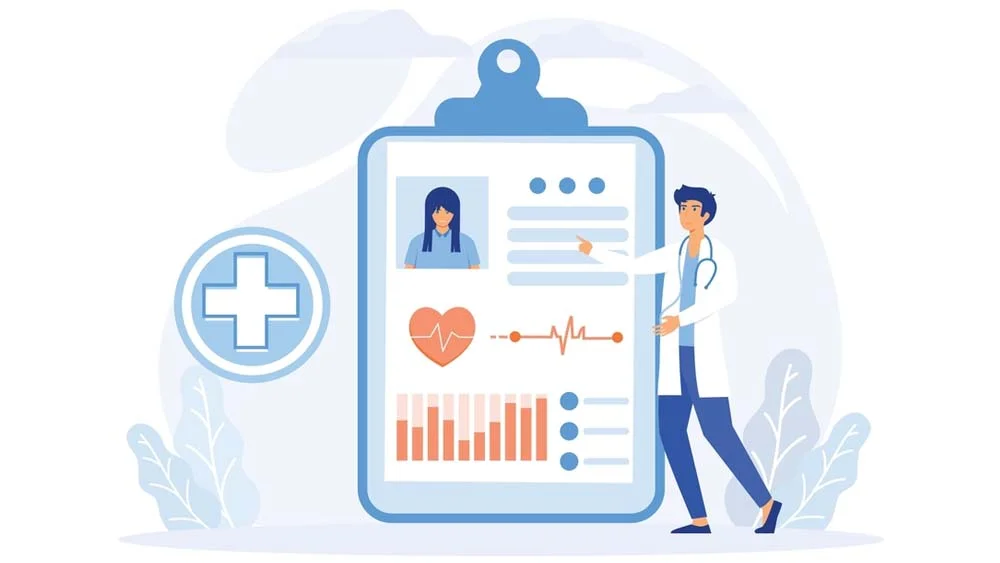
EHR systems are used to safely store, manage, and edit the digital version of patient paper charts. Not only does it allow medical staff to access the data quickly and conveniently, but it also saves space that archived paper records would otherwise take up. Additionally, EHR systems improve communication between healthcare providers. As they allow the sharing of patients’ information between different facilities. This is especially useful in the case of patients who need to continue their treatment in another location.
Another benefit is the ability to track and monitor patient progress based on the data stored in the system. Top EHR systems can help doctors make more informed decisions about their future care plans. As well as help analyze the data and spot patterns or trends that may indicate potential health problems.
Telemedicine apps
The pandemic has shown us how game-changing telemedicine apps are. The difficult situation the world had to face accelerated the growth of such software, and it remains in common use to this day.
Telemedicine apps are mostly used for remote doctors’ appointments and are extremely useful not only in providing convenient healthcare access for patients with routine medical needs but also in reducing the risk of exposure to contagious diseases in the clinic. It also makes it easier for patients from remote places to receive medical care without having to travel long distances.
Medical diagnosis software

Machine learning and, of course, artificial intelligence are starting to be integrated into more advanced healthcare apps. Helping to shape the way modern medicine is practiced. With many different diseases and symptoms to consider, sometimes diagnosing a patient may be difficult—especially in rare illnesses and complex conditions. By utilizing medical diagnosis software that uses artificial intelligence to analyze patient data much faster than a human doctor can make more accurate diagnoses in less time. Increasing the effectiveness of potential treatments.
While medical diagnosis software is still in its early stages. It has a big potential to completely revolutionize the field and improve patient outcomes. Additionally, by reducing the time needed from the patient’s initial consultation to receiving a diagnosis, such applications allow medical professionals to focus on other tasks.
Hospital management software
A useful tool for administrative tasks, hospital management software makes it easier to manage appointments, inventory, billing processes, and more. Many tasks can be automated, and the need for a human to manually input and manage data is greatly reduced. Freeing up valuable time for healthcare providers to focus on actual patient care instead of tedious tasks. It also allows for easier control of the hospital’s finances and resources, as tracking expenses is way easier with the use of this software.
Additionally, these all-encompassing tools make it easier for different hospital departments to cooperate. They all have access to the same information and can collaborate more efficiently on patient care and treatment plans.
E-Prescribing software
This tool, while often part of more complex, integrated hospital management systems, can also be used as a standalone solution. Of course, its main benefit is the convenience it offers to the patient. Who does not need to visit the medical facility to get a physical prescription? It is also easier for physicians. As they can quickly fill and send prescriptions without the need for paper-based processes.
E-prescribing software reduces the chance of the patient receiving a prescription for the wrong medication or not being able to purchase the medication due to illegible handwriting. This alone can significantly improve patient safety. Every year, millions of electronic prescriptions are sent through e-prescribing software. Saving time and speeding up the time it takes for patients to receive their medication.
Software That Changes the World
Health is one of the most important aspects of our lives. And software meant for hospitals, clinics, and other medical facilities plays a crucial role in improving our wellbeing. With hundreds of options on the market. Virtually every healthcare provider can find a software solution that will meet their needs and elevate the quality of care they are able to offer. Technology goes hand in hand with the healthcare industry. And the relationship between the two continues to bring about innovative solutions that make our lives easier. In conclusion, nandbox App Builder gives healthcare providers the ability to design unique apps that are suited to their particular requirements, improving patient care and operational effectiveness. Because of its user-friendly platform, medical facilities can easily integrate it with current systems and modernize their offerings.
The post Healthcare Software: Modern Solutions for Medical Facilities appeared first on nandbox Native App Builder.
]]>The post Mental Health in the Workplace: Why Training Applications Matters appeared first on nandbox Native App Builder.
]]>Why Mental Health Training is a Must
The simple answer is yes, employers should provide mental health training applications. Here’s why:
Mental Health Issues Are More Common Than You Think
Mental health problems affect more people than we realize. The World Health Organization says one in four people will deal with mental or neurological disorders at some point in their lives. That means, in any workplace, a lot of employees could be struggling with their mental health at any given time.
Work Can Be Stressful
Jobs come with pressure—tight deadlines, conflicts with co-workers, juggling work-life balance—it can all add up. Offering mental health training shows that employers understand these challenges and want to help their staff manage them.
Mental Health Affects Job Performance
When people are struggling mentally, their work can suffer too. Anxiety, depression, and other issues can lead to low productivity, missed days, or even people quitting. Training can help prevent that by giving employees the tools they need to cope and stay productive.
It’s a Legal and Ethical Responsibility
In many places, employers are required by law to look out for their employees’ well-being, which includes mental health. Plus, on an ethical level, companies should want to create a workplace where people feel supported.
Your organization can have some persons as mental health first aiders—you can book a training with caring for care for level 2 and 3 first aid mental health training. This will provide the necessary support for team members. Managers and team leads can take level 3 while everyone within the organization takes the level 2 training.
The Benefits of Mental Health Training Apps
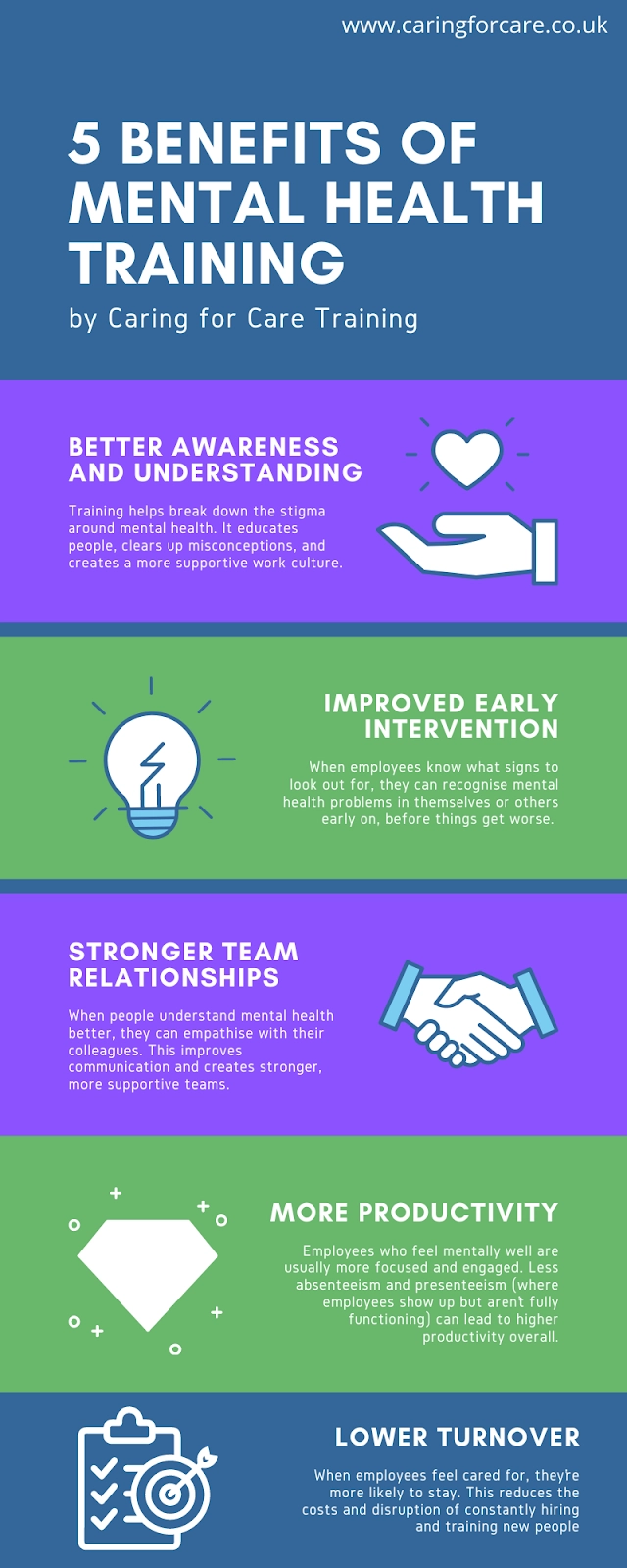
So, what are the real benefits of offering mental health training applications?
Here are a few:
Better Awareness and Understanding
Training Apps help break down the stigma around mental health. It educates people, clears up misconceptions, and creates a more supportive work culture.
Catch Issues Early
When employees know what signs to look out for, they can recognize mental health problems in themselves or others early on, before things get worse. This leads to better outcomes for everyone.
Happier, Healthier Employees
Training often includes tips on managing stress, finding work-life balance, and self-care. This can lead to a more content and mentally healthy workforce.
Reduced Stigma
Talking openly about mental health at work helps break the silence. Employees are more likely to speak up and seek help if they don’t feel there’s a stigma attached.
Stronger Team Relationships
When people understand mental health better, they can empathize with their colleagues. This improves communication and creates stronger, more supportive teams.
More Productivity
Employees who feel mentally well are usually more focused and engaged. Less absenteeism and presenteeism (where employees show up but aren’t fully functioning) can lead to higher productivity overall.
Lower Turnover
When employees feel cared for, they’re more likely to stay. This reduces the costs and disruption of constantly hiring and training new people.
Better Company Reputation
Companies that invest in mental health get a good reputation. This can help attract new talent, especially from younger generations who value mental health and work-life balance.
How to Start Mental Health Training at Work
It’s clear that mental health training is beneficial, but how can employers go about implementing it?
Here are some tips:
- Take a Broad Approach
Mental health training apps should be just one part of a bigger plan that includes things like flexible work policies and access to mental health support. - Offer Training Regularly
Don’t make mental health training apps a one-off event. Keep it going so employees stay engaged and the topic remains top of mind. - Involve Leaders
If company leaders get involved and openly support mental health training, it’ll have a bigger impact. Employees are more likely to take it seriously if management leads by example. - Tailor It to Your Workplace
Every workplace is different, so make sure the training reflects the specific challenges your employees face. - Bring in the Experts
It’s a good idea to bring in mental health professionals to run the training sessions. Their expertise will make the training more credible and effective. - Get Feedback
Ask your employees for feedback after each session. Use their insights to keep improving the training and making it relevant to their needs.
Conclusion
In today’s workplace, mental health can’t be ignored. It’s not a matter of whether employers should offer mental health training apps—it’s about how soon they can get started.
The benefits are clear: happier, healthier employees, a more productive and supportive workplace, and a better reputation for your company. By providing mental health training, employers send a powerful message—they genuinely care about their employees’ well-being.
This not only meets legal and ethical standards but also sets the company up for long-term success. The bottom line is that prioritizing mental health at work isn’t just a nice idea to have—it’s essential for workplace growth and well-being. The time to start is now.
The post Mental Health in the Workplace: Why Training Applications Matters appeared first on nandbox Native App Builder.
]]>The post The Role of IoT App Development in Modern Healthcare appeared first on nandbox Native App Builder.
]]>Improving Patient Care Through IoT
IoT technology has transformed care by facilitating continuous monitoring, prompt data collection and tailored treatment plans. These innovations not only boost outcomes but also elevate the overall quality of healthcare services. Developing applications is essential in today’s healthcare sector, as they offer IoT services for healthcare, allowing for constant monitoring and customized treatment strategies.
Remote Patient Monitoring

A key contribution of IoT to healthcare is IoT health monitoring (RPM). Devices like sensors, smartwatches and connected medical gadgets gather health information from patients and send it to medical professionals in real time.
For instance, Individuals dealing with illnesses such as diabetes or heart conditions can utilize devices to monitor their vital signs constantly. The data collected by these devices is transmitted to healthcare providers who can monitor the patients’ health remotely and intervene promptly if needed. This approach helps reduce hospital visits and enhance results.
Tailored Treatment Plans
Through IoT app development, personalized treatment plans can be crafted based on real-time data analysis. By keeping an eye on a patient’s well-being, applications can offer valuable insights to customize treatment according to the individual’s requirements.
For instance, a patient recovering from surgery could utilize a connected device to monitor their progress in recuperation. The data gathered can guide tailored physical therapy routines, medication modifications and postoperative care, leading to a speedier recovery process.
Enhancing Operational Efficiency and Cost Savings
IoT applications do not only enhance patient care but also boost operational efficiency and cut down costs for healthcare providers. These enhancements play a role in handling the growing demands for healthcare services.
Management of Assets and Tracking
The utilization of IoT technology empowers healthcare facilities to efficiently monitor and manage equipment and supplies. Through sensor assets whereabouts, usage patterns and conditions can be monitored in time, reducing losses and optimizing resource allocation.
For example, hospitals could employ sensors to track the locations of wheelchairs, infusion pumps and other essential equipment. This ensures that these assets are readily available when needed minimizing downtime and elevating the quality of care.
Automation of Workflows
The development of IoT applications facilitates workflow automation by streamlining tasks and enhancing staff productivity. Automated processes alleviate the workload on healthcare professionals, allowing them to dedicate time towards care.
IoT technology has a range of uses in the healthcare field, including streamlining tasks like check-ins, scheduling appointments and sending medication reminders. These advancements are often the result of innovative healthcare mobile app development, which combines IoT capabilities with intuitive software to improve patient outcomes and operational efficiency. By automating these processes, it lightens the load and lowers the chances of human errors, ultimately boosting efficiency.
Exploring Applications in Healthcare Settings
The role of technology in healthcare is diverse and expansive, covering various environments such as hospitals, clinics, home care services and telemedicine.
- Clinics
In healthcare facilities like hospitals and clinics, IoT tools play a role in improving patient care quality optimizing procedures and ensuring overall safety. Connected devices keep track of patients’ health status, monitor medical equipment usage patterns and regulate conditions for efficiency.
Smart beds equipped with sensors can monitor a patient’s movements, pressure points on the bed surface and vital signs. This data enables healthcare professionals to prevent bedsores, detect any falls promptly and manage pain levels effectively.
- Home Care Services
IoT applications also extend their benefits to home care settings by allowing patients to receive attention within their own residences. This setup proves advantageous for individuals or those managing chronic health issues.
For example: A smart pill dispenser can issue reminders for patients to take their medications as scheduled and notify caregivers if any doses are missed. This feature promotes medication adherence while reducing the risks associated with skipped doses.
- Telemedicine

Telemedicine services have seen a surge in popularity during times like the COVID-19. IoT devices are making consultations for healthcare providers by giving them real-time patient information, which helps in making accurate diagnoses and treatment plans.
For instance, a telemedicine platform that works with devices lets doctors keep track of a patient’s signs during a virtual appointment. This gives them a picture of the patient’s health, enhancing the quality of care.
Final Thoughts
In summary, the development of applications is revolutionizing healthcare by offering remarkable advantages in patient care, operational efficiency and cost savings. Whether it’s monitoring patients remotely creating treatment strategies, tracking assets or automating workflows, IoT technology is improving every aspect of healthcare delivery. As AI machine learning and connectivity progress further, the potential of IoT in healthcare will expand more, ushering in efficient and personalized healthcare systems. Embracing these advancements is crucial for healthcare providers who want to enhance outcomes and meet the changing needs of patients in this era.
The post The Role of IoT App Development in Modern Healthcare appeared first on nandbox Native App Builder.
]]>The post The Rising Demand: Why Translation Services Are Booming in 2024 appeared first on nandbox Native App Builder.
]]>The Globalization of Business
Expansion into New Markets
Globalization has opened up new opportunities for businesses to enter international markets. However, with these opportunities come challenges, particularly in communication. Companies that aim to establish a presence in foreign markets must navigate the complexities of language and cultural differences. This is where translation services come into play, enabling businesses to effectively communicate with diverse audiences.
For instance, in Quebec, a region known for its linguistic diversity, businesses rely heavily on professional translation services. They use them to engage with both French and English-speaking customers. Quebec translation services ensure that businesses can tailor their content to resonate with local audiences, thereby enhancing their brand’s credibility and appeal. Whether it’s translating marketing materials, product descriptions, or legal documents, the ability to accurately convey a message in a different language can make or break a company’s success in a new market.
E-commerce and Digital Transformation
With the rise of e-commerce and continued development in the digital sphere, the need for translation services continues unabated. The importance of online buying is coming into play in various countries. Many companies have thus focused their attention on reaching worldwide customers. For this easily achievable task, they have to provide multi-lingual websites and customer care to reach linguistic diversity among their consumers.
Nevertheless, localization services remain critical in translating websites, mobile applications, and marketing content to various regions. This may be considered as localization and not just translation. As it takes into consideration the cultural context of the consumers. In the process, professional translation services allow e-commerce to provide a consumer-friendly shopping experience across the globe. Therefore, improving sales for their businesses and customer loyalty.
The Impact of Technology on Translation Services
Advancements in Machine Translation
Technology has hugely transformed the translation industry, with huge advancements in machine translation. Platforms like MachineTranslation.com harness AI and machine learning to make translation quicker and more accurate, helping companies manage large volumes of content in multiple languages. Supporting more than 240 languages and offering an optional human review feature, this tool ensures a seamless translation experience tailored to diverse needs. These advancements have proven to be a boon for translation service providers, enabling much shorter turnarounds without sacrificing quality.
This does not mean, however, that machine translations replace human translators. The best translation service offers efficiency through AI with the ability to provide cultural and linguistic flair that only a human can create. This hybrid model ensures translations are not only accurate but resonate with the intended audience, all while maintaining integrity to the original message.
The Rise of Multilingual Content
In these digital times, companies are creating more content than ever. Starting from social media posts down to customer support interactions, the demand for multilingual content has grown exponentially. Translation services go hand in glove with businesses that feel this need to maintain a coherent brand voice across languages and platforms.
For example, global companies create social media customer engagement across multiple regions. This requires them to translate their content into several languages while keeping the tone and intent of the original message intact. Professional translation services ensure that companies are communicating effectively with their international audiences, leading to improved customer relationships and loyalty to brands.
Industries Driving the Demand for Translation Services
Healthcare and Medical Research

One of the major industries driving the growing demand for translation services is health. Medical research is conducted worldwide, and the need for such information to be shared across borders calls for translation. Translation services are in high demand regarding various documents, including those on medical journals, clinical trial reports, and patient data. The stakes are just so very high. Any errors in translation may lead to misunderstandings, misdiagnoses, or even legal repercussions.
Translation services play another very important role in ensuring all regulations set by other countries are followed. In situations like this, pharmaceutical companies engaged in many countries may be bound by regulatory requirements to insert product information and instructions in the native language. Partnering with a medical translation service provider is essential for healthcare organizations to ensure their communications are clear, accurate, and fully compliant with legal requirements.
Legal and Financial Sectors
The demand for translation services is equally vital in legal and financial departments. Legal documents include contracts, patents, and court filing materials that need to have exactly worded translations to leave no room for ambiguities or misinterpretations. Financial reports, audits, and other financial documents require translations that are accurate to ensure transparency and compliance with international norms.
As businesses continue to grow more globally, the need for accurate translation for these industries will also further increase. This demands professional translators who can handle legal and financial terminology. This is to provide the company with competent translations of documents while retaining their meaning across languages.
Education and E-learning
This demand was influenced by the rise of online education and e-learning platforms as well. Educational institutions and companies have to make their courses and materials available in various languages to expand globally. Translation services are a must for educational content. It needs to be adapted to different linguistic and cultural contexts, so learners from all over the world can access and benefit from these resources.
Be it textbook translation, online course translation, or translation of instructional videos, professional translation services help educational providers increase their reach and impact. In this way, they can reach a more diverse pool of students while contributing toward the spread of global knowledge.
The Competitive Edge of Professional Translation Services
Quality and Accuracy
One of the main reasons businesses turn to professional translation services is the assurance of quality and accuracy. While machine translation tools can provide quick translations, they often lack the nuance and cultural understanding required for effective communication. Professional translators bring a deep understanding of both the source and target languages, ensuring that the final product is accurate and culturally relevant.
In industries where precision is paramount, such as healthcare, legal, and finance, the importance of quality translation cannot be overstated. By investing in professional translation services, businesses can avoid costly mistakes and maintain their reputation in the global market.
Cultural Sensitivity and Localization

Another critical advantage of professional translation services is their ability to provide cultural sensitivity and localization. Localization goes beyond translating words; it involves adapting content to fit the cultural norms and expectations of the target audience. This is particularly important in marketing, where a culturally insensitive message can damage a brand’s reputation.
Translation services that offer localization ensure that the content resonates with the target audience, increasing the likelihood of success in a new market. By considering cultural nuances, businesses can create a more authentic and engaging experience for their customers.
The Future of Translation Services
Continued Growth and Innovation
The demand for translation services is expected to continue growing as businesses increasingly operate on a global scale. With ongoing advancements in technology, the translation industry will likely see further innovations that enhance the quality and efficiency of services. However, the need for human expertise will remain critical, as cultural and linguistic nuances cannot be fully captured by machines.
The Role of Translation Services in Shaping Global Communication
As we move further into the digital age, translation services will play an even more vital role in bridging language barriers and facilitating global communication. Whether for business, education, healthcare, or legal purposes, translation services are essential for connecting people and ideas across borders. In 2024 and beyond, these services will continue to be a cornerstone of successful global strategies.
Conclusion
In today’s globalized world, translation services are no longer a luxury but a necessity. From helping businesses expand into new markets to ensuring clear communication in critical industries, the demand for high-quality translation services is only set to increase. As businesses navigate the complexities of a global market, partnering with professional translation services will be key to their success.
The post The Rising Demand: Why Translation Services Are Booming in 2024 appeared first on nandbox Native App Builder.
]]>The post Custom Healthcare App Development Services: Tailoring Solutions to Meet Unique Needs appeared first on nandbox Native App Builder.
]]>Understanding Custom Healthcare Apps
These applications enhance various aspects of healthcare management, including patient scheduling, medical record access, remote monitoring, and doctor reputation management. By focusing on specific requirements and integrating seamlessly with existing healthcare systems, these apps improve efficiency and patient outcomes. They also support real-time communication and data exchange, ensuring that healthcare providers can make informed decisions quickly. Overall, custom healthcare apps represent a significant advancement in the digital transformation of healthcare.
Benefits of Custom Healthcare Apps
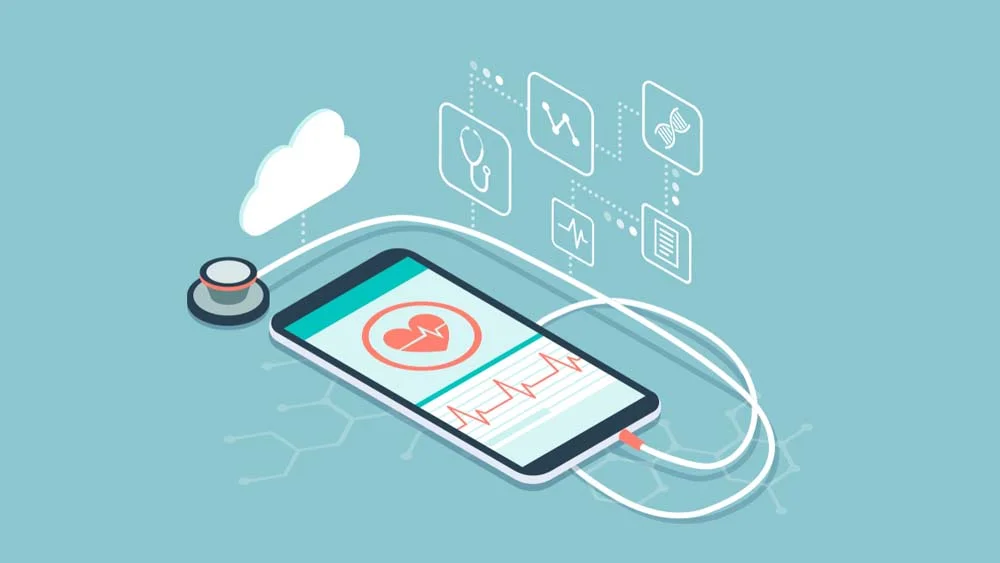
Custom healthcare apps offer a multitude of benefits that significantly enhance both patient care and the operational efficiency of healthcare providers. Firstly, these apps can streamline processes such as appointment scheduling and patient registration, reducing administrative workload and increasing patient satisfaction. They also provide healthcare professionals with easy access to critical patient data, such as medical histories and test results, which can improve the accuracy and speed of diagnosis and treatment. Moreover, custom apps facilitate better patient engagement by allowing patients to monitor their health, access educational resources, and communicate directly with their healthcare providers. This leads to improved health outcomes and patient adherence to treatment plans. Additionally, with features like data encryption and secure channels, these apps ensure high standards of data privacy and security, crucial in maintaining patient trust and complying with healthcare regulations.
Key Features of Effective Healthcare Apps
User-friendliness is paramount; an intuitive interface ensures that users of all ages and tech-savviness can navigate the app without confusion, making healthcare more accessible. Security features are also critical, as they protect sensitive patient data from unauthorized access, with encryption and secure authentication processes being standard. Real-time functionality is another essential feature, allowing for the continuous monitoring of patient health and immediate updates to medical records, which can be crucial in emergency situations. Additionally, interoperability with other healthcare systems ensures that the app can integrate seamlessly with existing hospital and clinic software, facilitating a smoother workflow and reducing errors. Finally, personalized patient communication tools, such as push notifications for medication reminders and appointments, enhance patient engagement and compliance with treatment protocols.
Developing Your Healthcare App

Custom healthcare app development services involve a strategic and detailed process to ensure it meets the specific needs of the healthcare environment it serve. The first step is to conduct thorough research to understand the unique challenges and requirements of the target users, whether they are healthcare professionals, patients, or administrative staff. This phase might involve reviewing resources such as https://inveritasoft.com/industries/healthcare to gain insights into the specific needs and solutions in the healthcare industry. Based on this research, defining clear objectives for the app is crucial, such as improving patient engagement, streamlining clinical workflows, or enhancing diagnostic accuracy.
The next phase involves designing the user interface and experience, focusing on simplicity and accessibility to accommodate users of varying technological expertise. Technical development follows, where features like secure data storage, real-time updates, and integration capabilities with existing healthcare systems are implemented. Finally, rigorous testing is essential to ensure the app functions correctly across different devices and platforms, and complies with all relevant health regulations and privacy standards.
Challenges in Healthcare App Development
Developing healthcare apps comes with a unique set of challenges that must be carefully navigated to ensure success. One of the primary obstacles is compliance with stringent healthcare regulations such as HIPAA in the United States, which governs the privacy and security of patient data. Ensuring data security is another major challenge, as healthcare apps handle sensitive information that is a prime target for cyberattacks. Developers must implement robust security measures like encryption and secure authentication to protect this data.
Interoperability is another significant hurdle, as the app must seamlessly integrate with various existing healthcare IT systems, which often use different standards and technologies. The user experience must also be prioritized, designing interfaces that are accessible to users of all ages and levels of tech-savviness, which can be difficult given the complex nature of medical data.
Moreover, maintaining the accuracy of medical information within the app and ensuring it delivers reliable and timely data to both patients and healthcare providers is crucial. Finally, the need for ongoing updates and maintenance to adapt to evolving medical practices and technological advancements presents a continuous challenge.
Choosing the Right Development Partner
When selecting a partner, it’s important to consider their experience and track record in developing healthcare applications. A good development partner should have a deep understanding of the healthcare industry’s compliance and regulatory requirements, such as HIPAA in the U.S., to ensure the app meets all legal standards.
It’s also beneficial to review case studies or testimonials from previous clients to gauge the effectiveness of their solutions in real-world healthcare settings. Technical proficiency in secure coding practices, data encryption, and user interface design are essential skills your partner should possess. Lastly, effective communication and a clear project management methodology are key to ensuring that the development process is smooth and that the final product aligns with your goals.
Conclusion
Custom healthcare app development services present a promising avenue for enhancing the efficiency and effectiveness of healthcare services. These apps are tailored to meet the specific needs of healthcare providers and patients, offering solutions that streamline operations, improve patient engagement, and ensure high standards of care. However, the journey to creating a successful healthcare app involves overcoming several challenges, including strict regulatory compliance, ensuring robust security, and achieving seamless integration with existing systems. Choosing the right development partner with expertise in healthcare technology and a proven track record is essential. As healthcare continues to evolve with technological advancements, custom apps will play a pivotal role in shaping the future of patient care. By focusing on user-centric design and continuous innovation, healthcare apps can greatly contribute to a more efficient and responsive healthcare system.
The post Custom Healthcare App Development Services: Tailoring Solutions to Meet Unique Needs appeared first on nandbox Native App Builder.
]]>The post Maximizing Efficiency: How Cooperative Procurement Transforms Key Industries appeared first on nandbox Native App Builder.
]]>-
Healthcare Industry
The healthcare industry is one of the most prominent beneficiaries of cooperative procurement. Hospitals, clinics, and other healthcare providers often face tight budgets and the need for high-quality medical supplies and equipment. Group purchasing organizations (GPOs) in healthcare pool the purchasing power of multiple institutions to negotiate better prices and terms with suppliers.
Key Benefits:
– Cost Savings: By buying in bulk, healthcare providers can significantly reduce the costs of medical supplies, pharmaceuticals, and equipment.
– Quality Assurance: Cooperative procurement ensures access to high-quality products that meet strict regulatory standards.
– Operational Efficiency: Streamlined procurement processes and reduced administrative burden allow healthcare providers to focus more on patient care.
-
Educational Institutions
Colleges, universities, and diverse K-12 school districts benefit greatly from purchasing contracts for education. These institutions often need a wide range of supplies, from classroom materials and textbooks to technology and facilities maintenance services.
Key Benefits:
– Budget Management: Cooperative procurement helps educational institutions manage tight budgets by securing better prices for essential supplies.
– Resource Sharing: Schools and colleges can share resources and expertise, leading to improved procurement practices and cost efficiency.
– Enhanced Quality: Access to high-quality educational materials and technology supports better learning outcomes for students.
-
Government and Public Sector
Government agencies and public sector organizations at local, state, and federal levels frequently engage in cooperative procurement. These entities are often under pressure to maximize taxpayer dollars while delivering public services efficiently.
Key Benefits:
– Cost Efficiency: Cooperative procurement allows public sector organizations to achieve economies of scale and reduce costs for goods and services.
– Transparency and Accountability: Group purchasing arrangements promote transparency and accountability in procurement processes, reducing the risk of corruption and fraud.
– Standardization: Cooperative procurement helps standardize the quality of products and services across different government agencies.
-
Nonprofit Organizations for cost savings
Nonprofit organizations, including charities, foundations, and community service organizations, often operate with limited budgets and rely on donations and grants. Cooperative procurement enables these organizations to stretch their funds further and achieve their missions more effectively.
Key Benefits:
– Cost Savings: Nonprofits can access discounted prices for supplies, technology, and services through cooperative purchasing agreements.
– Resource Optimization: By pooling resources, nonprofits can optimize their procurement processes and reduce administrative costs.
– Enhanced Impact: Cost savings achieved through cooperative procurement allow nonprofits to allocate more funds directly to their programs and services.
-
Retail

The retail industry, particularly small and medium-sized retailers, can benefit significantly from cooperative procurement. By joining forces with other retailers, these businesses can achieve better pricing and terms for the products they sell.
Key Benefits:
– Competitive Pricing: Cooperative procurement helps retailers secure lower prices from suppliers, allowing them to offer competitive pricing to consumers.
– Inventory Management: Retailers can better manage their inventory levels and reduce the risk of overstocking or stockouts.
– Supply Chain Efficiency: Group purchasing arrangements streamline the supply chain, leading to more efficient and reliable delivery of goods.
-
Manufacturing
Manufacturers, especially those in small and medium-sized enterprises (SMEs), often face challenges in securing raw materials and components at competitive prices. Cooperative procurement allows these manufacturers to pool their buying power and negotiate better deals with suppliers.
Key Benefits:
– Cost Reduction: Manufacturers can lower the costs of raw materials and components through bulk purchasing.
– Supplier Relationships: Cooperative procurement fosters stronger relationships with suppliers, leading to more reliable supply chains and better terms.
– Innovation: By collaborating with other manufacturers, companies can share knowledge and innovations, driving industry advancements.
-
Agriculture and Food Industry
The agriculture and food industry, including farmers, food processors, and distributors, benefits from cooperative procurement by securing better prices for seeds, fertilizers, equipment, and other essential supplies.
Key Benefits:
– Cost Efficiency: Farmers and food producers can reduce input costs by purchasing supplies in bulk through cooperative arrangements.
– Market Access: Cooperative procurement helps small farmers and producers gain access to larger markets and better distribution networks.
– Sustainability: By working together, agricultural cooperatives can invest in sustainable practices and technologies that benefit the entire industry.
Cooperative procurement offers substantial benefits across various industries. By leveraging collective buying power, organizations in these sectors can achieve significant cost savings, improve the quality of goods and services, and enhance operational efficiency.
The post Maximizing Efficiency: How Cooperative Procurement Transforms Key Industries appeared first on nandbox Native App Builder.
]]>The post The Benefits of a Lifestyle Savings Account Over a Typical Healthcare Savings Account appeared first on nandbox Native App Builder.
]]>Flexibility in Spending
Broad Range of Eligible Expenses
One of the most significant advantages of Lifestyle Savings Accounts (LSAs) is their flexibility. Lifestyle Savings Account can cover a wide array of expenses that go beyond healthcare. This includes fitness memberships, mental health services, personal development courses, hobbies, travel, and more. This broad scope allows employees to use their benefits in ways that genuinely enhance their quality of life and personal satisfaction.
Personalization and Customization
Employers can tailor LSAs to meet the specific needs and interests of their workforce. By offering a variety of eligible expenses, employers can address diverse employee preferences and lifestyles, fostering a more inclusive and supportive work environment. This customization helps in creating a unique and attractive benefits package that can differentiate an employer in a competitive job market.
Enhancing Employee Well-being and Productivity
Holistic Approach to Wellness
LSAs support a holistic approach to employee wellness by addressing physical, mental, and emotional health. While HSAs are limited to medical expenses, LSAs encourage employees to engage in activities that reduce stress, improve mental health, and foster personal growth. This comprehensive approach to well-being can lead to increased job satisfaction, reduced burnout, and lower absenteeism.
Boosting Employee Engagement

Employees who feel supported in their overall well-being are more likely to be engaged and productive at work. LSAs can fund activities and services that employees are genuinely passionate about, contributing to a sense of fulfillment and motivation. This increased engagement can result in higher productivity, better job performance, and a stronger commitment to the organization.
Addressing the Needs of the Modern Workforce
Catering to Diverse and Changing Preferences
The modern workforce is diverse and has evolving preferences. Employees today value flexibility and personalized benefits. LSAs meet these expectations by offering a range of options that cater to different lifestyles and life stages. Whether it’s a young professional seeking personal development opportunities or a parent looking for wellness activities for their family, LSAs provide the flexibility to support varied needs.
Attracting and Retaining Talent
In a competitive job market, offering unique and attractive benefits is crucial for attracting and retaining top talent. LSAs can be a key differentiator in an employer’s benefits package. By demonstrating a commitment to employee well-being beyond traditional healthcare, employers can position themselves as forward-thinking and employee-centric. This can enhance their reputation and make them more appealing to potential hires.
Financial and Administrative Advantages
Employer-Controlled Contributions
Unlike HSAs, which often involve employee contributions, employers typically fund LSAs entirely. This allows employers to control the amount allocated to LSAs, manage costs effectively, and design the program according to their budget. Additionally, the funds in an LSA can be non-taxable to the employee if structured appropriately, depending on local regulations.
Simplified Administration
LSAs can simplify the administration of employee benefits. Since LSAs are not bound by the same regulatory requirements as HSAs, employers have more flexibility in defining eligible expenses and managing the account. This can reduce the administrative burden and allow for more straightforward implementation and management of the benefit program.
Future-Proofing Employee Benefits
Adapting to Workforce Trends
As workforce trends continue to evolve, so too must employee benefits. LSAs offer a future-proof solution by being adaptable and responsive to changing employee needs and preferences. This adaptability ensures that the benefits program remains relevant and valuable, helping employers stay ahead in the competitive landscape.
Supporting Remote and Hybrid Work Models
The rise of remote and hybrid work models has further underscored the need for flexible benefits. LSAs can support remote employees by funding activities and services that enhance their home-office experience, promote work-life balance, and encourage healthy lifestyles. This is particularly important in maintaining employee well-being and productivity in a remote or hybrid work environment.
The Lifestyle Savings Account represents a significant advancement in employee benefits, offering flexibility, personalization, and a holistic approach to well-being that traditional Healthcare Savings Accounts cannot match. As organizations strive to create supportive and dynamic work environments, LSAs stand out as a powerful tool for promoting overall employee satisfaction and productivity.
The post The Benefits of a Lifestyle Savings Account Over a Typical Healthcare Savings Account appeared first on nandbox Native App Builder.
]]>The post The Impact of Telemedicine on Healthcare Accessibility appeared first on nandbox Native App Builder.
]]>The Rise of Telemedicine
Telemedicine has a long history, dating back to the early 20th century, when radio was used to give medical advice to sailors at sea. However, it is only in the last two decades that telemedicine has evolved into a comprehensive healthcare solution.
The widespread availability of the internet and advancements in medical technology have driven this evolution, making the rise of telemedicine a critical component of modern healthcare.
Several factors have contributed to the of telemedicine:
- Technological Advancements: Improved internet connectivity and the proliferation of smartphones and tablets have made telemedicine accessible to a larger population.
- Policy Changes: Governments and healthcare organizations have implemented policies that support telemedicine, especially in response to the COVID-19 pandemic.
- Consumer Demand: Patients increasingly prefer the convenience of virtual consultations, which eliminate the need for travel and reduce waiting times.
Enhancing Healthcare Accessibility
One of the most significant impacts of the rise of telemedicine is its ability to bridge the gap in healthcare accessibility in rural areas. Many rural communities face challenges such as a shortage of healthcare providers, long travel distances to the nearest medical facility, and limited access to specialized care. Telemedicine addresses these issues by providing:
- Virtual Consultations: Patients can consult with healthcare providers from the comfort of their homes, reducing the need for travel.
- Specialist Access: Rural patients can access specialist care that may not be available locally.
- Continuous Monitoring: Telemedicine allows for continuous monitoring of chronic conditions, ensuring timely intervention and reducing hospital admissions.
Cost Savings for Patients & Healthcare Providers

Telemedicine can significantly reduce healthcare costs for patients. By eliminating the need for travel and reducing time off work, patients can save on both direct and indirect expenses. Additionally, telemedicine can lead to better management of chronic conditions, reducing the need for costly emergency room visits and hospitalizations.
Healthcare providers also benefit from telemedicine through cost savings and increased efficiency. Virtual consultations can reduce overhead costs associated with running a physical clinic. Moreover, telemedicine allows providers to see more patients in less time, improving productivity and patient satisfaction.
Improving Access for Underserved Populations
Telemedicine also plays a crucial role in improving access to healthcare for underserved populations, including:
- Low-Income Communities: Telemedicine can reduce healthcare costs by eliminating travel expenses and minimizing time off work.
- Older People and Disabled Individuals: For those with mobility issues, telemedicine offers a convenient way to receive medical care without the need to leave their homes.
- Minority Communities: Telemedicine can help address healthcare disparities by providing access to culturally competent care providers who may not be available locally.
Enhancing Quality of Care
Continuity of Care
Telemedicine enhances the continuity of care by facilitating regular follow-ups and ongoing monitoring. Patients with chronic conditions can receive timely interventions, reducing the risk of complications and improving health outcomes. Additionally, certain supplements like sucrosomial magnesium can aid in managing chronic conditions by improving nutrient absorption and overall health.
Access to Specialists
Telemedicine provides patients with access to a broader range of specialists. This is particularly important for those with rare or complex conditions that require specialized expertise. Through telemedicine, patients can receive expert opinions without the need for long-distance travel.
Patient Engagement
Telemedicine fosters greater patient engagement by making it easier for patients to communicate with their healthcare providers. Through virtual consultations, patients can ask questions, discuss concerns, and receive personalized advice, leading to better adherence to treatment plans and improved health outcomes.
Telemedicine vs. Traditional Healthcare
| Aspect | Telemedicine | Traditional Healthcare |
| Accessibility | Remote consultations from any location | Requires travel to healthcare facilities |
| Cost | Reduces travel and indirect expenses | Includes travel costs and time off work |
| Specialist Access | Easy access to a wide range of specialists | Limited to local availability |
| Continuity of Care | Facilitates regular follow-ups and monitoring | May involve longer intervals between visits |
| Technological Requirements | Requires internet access and digital literacy | No internet or digital skills needed |
Challenges and Solutions
Technological Barriers
Despite its many benefits, telemedicine faces several challenges. Technological barriers, such as lack of access to high-speed internet or digital literacy, can limit the adoption of telemedicine in certain populations. Addressing these barriers requires:
- Infrastructure Development: Investing in internet infrastructure to ensure high-speed connectivity in rural and underserved areas.
- Digital Literacy Programs: Implementing programs to educate patients and healthcare providers on how to use telemedicine platforms effectively.
Regulatory and Reimbursement Issues
Regulatory and reimbursement issues also pose challenges to the widespread adoption of telemedicine. Different states and countries have varying regulations regarding telemedicine, and reimbursement policies can be inconsistent. Solutions include:
- Unified Regulations: Developing unified regulations that facilitate the use of telemedicine across different regions.
- Reimbursement Policies: Establishing clear and consistent reimbursement policies to ensure that healthcare providers are adequately compensated for telemedicine services.
Privacy and Security Concerns

Privacy and security concerns are paramount in telemedicine, as sensitive patient information is transmitted electronically. Ensuring the security of telemedicine platforms involves:
- Robust Security Measures: Implementing encryption and other security measures to protect patient data.
- Compliance with Regulations: Ensuring that telemedicine platforms comply with healthcare privacy regulations such as HIPAA.
Future of Telemedicine
The future of telemedicine lies in its integration with traditional healthcare systems. Hybrid models that combine in-person and virtual care can provide the best of both worlds, offering patients the flexibility of telemedicine while maintaining the benefits of face-to-face interactions.
Advancements in technology will continue to drive the evolution of telemedicine. Innovations such as artificial intelligence, wearable devices, and remote monitoring tools will enhance the capabilities of telemedicine, allowing for more accurate diagnoses and personalized treatment plans.
Telemedicine has the potential to make a global impact by improving healthcare accessibility in developing countries. By leveraging telemedicine, healthcare providers can reach remote and underserved populations, addressing healthcare disparities on a global scale.
Frequently Asked Questions
- Can telemedicine completely replace in-person visits?
While telemedicine offers many benefits, it is not a complete replacement for in-person visits. Some medical conditions and treatments require physical examinations and face-to-face interactions with healthcare providers.
- How does telemedicine improve access to healthcare?
Telemedicine makes it easier for patients in remote or underserved areas to receive medical care without the need for long-distance travel, and it provides access to specialists who may not be locally available.
- Is telemedicine safe and secure?
Yes, telemedicine platforms are designed with robust security measures, including encryption, to protect patient information. They also comply with healthcare privacy regulations such as HIPAA.
- What are the cost benefits of telemedicine?
Telemedicine reduces costs by eliminating travel expenses, minimizing time off work, and reducing the need for expensive emergency room visits and hospitalizations.
The post The Impact of Telemedicine on Healthcare Accessibility appeared first on nandbox Native App Builder.
]]>The post The Ultimate Guide to Choosing the Purrfect App for Pets appeared first on nandbox Native App Builder.
]]>Pets are a major part of many people’s lives. Well, they are for me, given that I have a high chance of becoming a cat devotee. However, there is one thing that is a major part of our lives, and this would be applications. Applications have a fundamental presence in anyone’s life, as they take care of most of it and make it much easier. From transportation to retail, and more. Hello! What does this have to do with pets? Well, aren’t they one of the aspects that can be taken care of by application? If this is a new fact for you, then you should read this article. In this article, we will demonstrate the emerging category of pet apps, which covers everything from pet care to vet services. Read on to learn how to choose the perfect app and make your pets’ lives better and more comfortable!
The Evolution of Pet Care Through Mobile Apps and How Did It Start?
Back in the day, pet care and pet services were very limited. This is because, for many people, they were completely unaffordable and inaccessible in some other cases. The presence of the Internet and online platforms made things easier, but not to a great extent. platforms were usually limited to pet products and scarcely anything else. Through the pandemic, people couldn’t access anything, even the hardly accessible services like vet and pet care. This came as a major and serious problem for all pet owners, causing millions of pets’ health to be in danger.
This stressful and unpleasant situation caused many pet owners to start looking for more effective solutions that would be useful in times like this. Luckily, they found the ultimate solution for all problems during the pandemic, which were applications. Although the pet care and services category wasn’t universal at the time, a small number of apps were available for such a cause. However, after the pandemic, the number in this category increased significantly and is still at an outstanding inclination rate.
There has been a complete turnaround in how pet owners think about their pets’ health and care since the advent of pet apps. The broad use of smartphones as part of our daily lives marks the beginning of this transformation. The demand for effective, user-friendly solutions in pet care arose alongside the widespread adoption of mobile devices and the resulting increase in productivity they enable. The earliest forms of pet apps for mobile devices provided just the most basic features, such as vaccination records, food logs, and reminders for vet visits.
This initial stage saw these apps as basic but valuable tools for streamlining pet care tasks. Sometime later, developers stepped up to meet the growing need for more complex functions by building apps that did more than just monitor health. They had more features that could also measure physical activity levels, provide nutritional counsel, and even help with lost-pet recoveries. This was a monumental change in how people cared for their pets’ welfare and well-being.
The Benefits and challenges of pet apps
Benefits
Health Monitoring
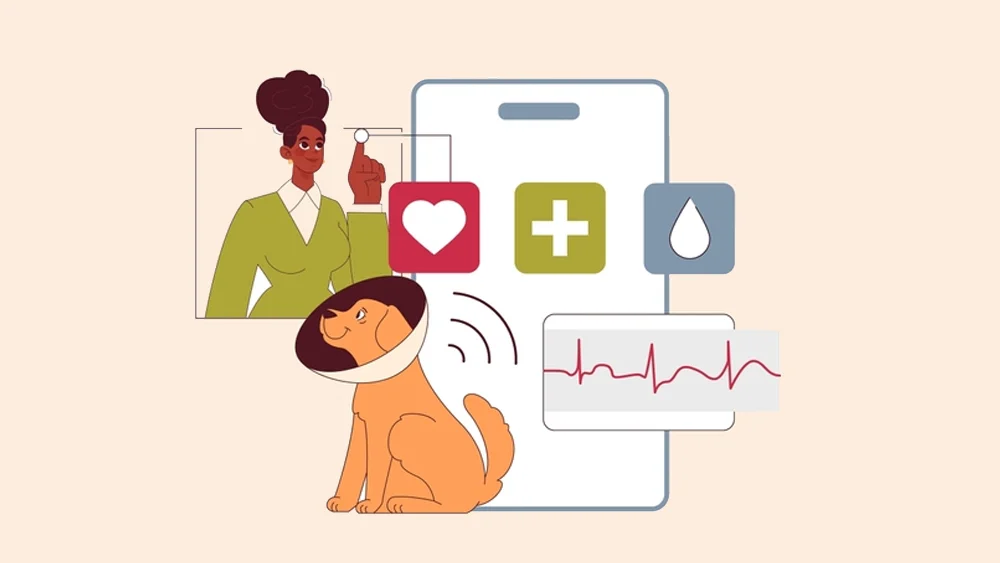
You can keep tabs on your pet’s vaccines, medicines, medical appointments, weight, and physical activity with the help of an app for pets. This is important for your pet’s health and enables immediate and swift medical attention in case of an emergency.
Nutritional Management
Depending on the app, you may be able to get nutrition advice for your pet, including recommendations for foods, serving sizes, and feeding schedules. This would be extremely beneficial to improve your pet’s health, especially senior ones.
Activity Tracking
![]()
Many pet applications include activity trackers to help you keep track of your pet’s activities and playtime. They can give you information about your pet’s activity levels, which can encourage you to keep them healthy and engaged.
Lost Pet Features
Some pet apps have features to help find missing pets, such as the ability to create digital profiles with identification information and the ability to share warnings with a network of other pet owners. This can help locate lost pets by tapping into a user-populated database and GPS tools.
Community Engagement
The community of pet owners can be strengthened through the use of these applications because many of them have built-in forums or social aspects. These help users talk to one another about their pets and offer each other advice.
Online Shopping and Services
Many pet care apps now include links to online pet retailers, where owners can quickly and easily stock up on things like food, treats, and medications. Some also offer other services for pets, such as grooming, training, and consultations with veterinarians.
Convenience and Accessibility
In general, these applications simplify the process of caring for pets by assembling a variety of tasks into a single location. These can be accessed at any time using a mobile device, such as a smartphone or tablet.
Challenges
User Adoption and Engagement
It can be difficult to increase the app’s user base and maintain their regular participation. A lack of user-friendliness or interesting features in an app can cause people to stop using it. Therefore, increasing churn and abandonment rates for apps.
Data Accuracy and Updates
It might be difficult to keep track of every piece of information related to pet care, including their vaccination history, veterinary appointments, and more. Data could get outdated and inaccurate if users don’t update and maintain their records or if there are problems with syncing.
Variability in Pet Needs
Every pet has unique requirements, and it would be impossible for any app to meet them all. It’s possible that some users won’t find the application particularly helpful because it doesn’t work with their particular pet’s species or breed.
Reliability on Connectivity
Internet access is required for many aspects of pet apps. Users may encounter difficulties gaining access to or updating information if there are network issues or if the application demands a constant online connection.
Cost of Development and Maintenance
Developing and updating a feature-rich app for pets, as well as providing customer service and keeping the app’s servers up and running, are all costly tasks. These are all major problems, especially for startups and beginner developers. Ads, subscriptions, and in-app purchases are just a few examples of monetization tactics that could be needed to overcome such a challenge.
The Best Pet Care Apps on the Market
1. GoodPup
The first app on our list is GoodPup, which is widely used among all pet owners, especially dogs. Dog owners suffer, especially at the very beginning. This is because dogs and puppies need extensive training to be able to adapt to a new environment. Unlike cats, which easily and quickly adapt to the surrounding environment. GoodPup offers exceptional training services from hundreds of experts that can be accessed through the application. All they need to do is book a training appointment with an expert that they see fits their requirements. They can then have video training sessions and frequent checkups.
2. GreatPetCare
The second app on the list is GreatPetCare. GreatPetCare is an ideal app for pets’ health to keep them on track. This app makes the veterinary experience for pet owners more organized and efficient. But how is that? The app allows pet owners to upload all their pet’s information and vet records that the vet can access at any time or visit. They could also keep records of all the previous diagnoses, medications, vaccinations, and so on. This will reduce the risk of misdiagnosis that frequently happens at vets. Additionally, the app has a reminder feature that would alert pet owners to any upcoming medications and vaccinations.
3. Airvet
Lastly on the list is Airvet. During the great lockdown and pandemic, the whole world stopped, not only for individuals but for pets as well. As there were no vet services available, apps like Airvet were the ultimate solution that helped many pets everywhere. This app offers virtual vet and pet care services. This includes virtual vet visits, pet advice, and many more things that pet owners need regularly. The only difference is that the services are more accessible and cost-efficient.
Top Pet Apps Trends in 2023
Pet Tracking Apps
The first place in the newest app for pet trends goes to pet tracking apps. With the rise of new technologies like wearables and advanced Bluetooth tracking devices, these types of apps emerged. Devices like the Apple Tag make it so easy for a pet owner to always keep an eye on his or her pets wherever they go. By connecting these tracking devices to a pet tracking application, they would have a detailed report of their location and track them anywhere they are. They could also get alerts and reminders whenever they wander off. This helps pet owners keep their pets safe and never experience the grief of losing a pet.
Pet Social Network
Did you know that your pet can now make connections and friends easily? Well, this means that you also get to make friends and connections. Pet social networks help establish a great network of pet owners in the same or nearby communities. As a result, pet owners would be able to discuss similar interests and topics, get advice, plan events, and so on. These apps not only help pet owners to socialize and have access to a helpful community but also for pets to socialize and have fun!
Pet Sitter and Walker Apps

The third app on the list is pet sitters and walkers apps. These apps help ease the burden on pet owners in many cases. For instance, some pet owners wouldn’t have enough time to walk their dogs sometimes, and some would need to be away for some time with no one to watch their pets. Pet sitters and walker apps help connect pet owners to people who are willing to do these tasks. They can choose from a rich list based on location, budget, and many other specifications they can set.
Pet Adoption Apps
Who doesn’t like the idea of having a pet friend that would definitely be a joy in their lives? Well, no one, maybe some villains, but even villains own pets sometimes. I mean, Gargamel has Azrael.
The adoption process for pets is very complex, with many procedures and papers taking place. In addition, people needed to make an enormous effort to find a pet by going from one shelter to another, exerting much effort and spending time. However, the presence and flexibility of the application made this process much easier. Through pet adoption apps, people can see all the available pets at every shelter, or one shelter if it has a specific app. They can then go through the whole process digitally and seamlessly in a matter of minutes.
En Fin
The way that an app can have an impact on our lives is unforeseen, even for our pets. This started with necessities such as pet health and is now covering luxuries such as pet service. Applications are transforming pet care and making it more efficient and accessible, even for people who never had access to pet services before. But luckily, this is long gone now. The app market for pet services is still anticipating a lot of contributions from developers to cover other areas. However, contributions can be made not only for developers now.
Thanks to no-code and low-code development, anyone can be a part of the app market now. Many app builders now, such as the nandbox app builder, are offering users all the necessary tools for creating the best pet apps. And we know that you’d think that this must come with a hefty price tag, but you are wrong. The nandbox app builder, for instance, offers three affordable price plans that anyone can afford. The basic plan starts at $49 and comes with all the features that would make an exceptional app for pets. So, if you are a pet lover with a great vision and idea for a new pet app, then nandbox is definitely the place for you! Try the nandbox app builder now and enjoy a free 15-day trial.
The post The Ultimate Guide to Choosing the Purrfect App for Pets appeared first on nandbox Native App Builder.
]]>